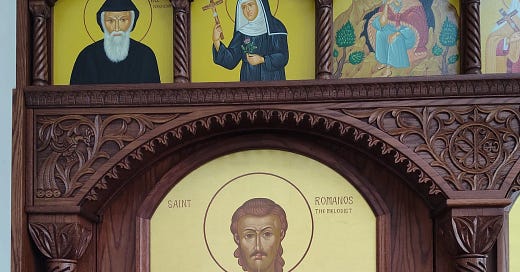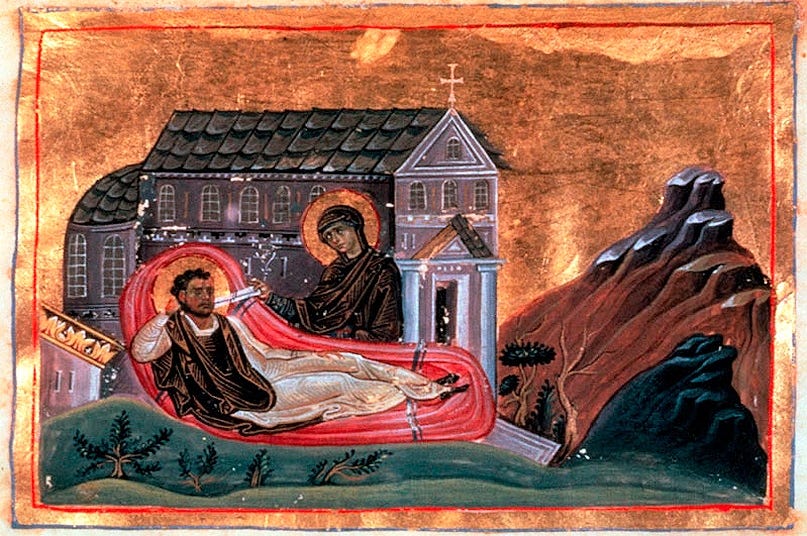One of the things you notice when you start peering across the East-West divide of Christianity is how many Saints of the undivided Church do not cross that divide. To borrow a phrase from a 20th Century Canadian writer, East and West are “two solitudes” which may live side by side but speak different languages and do not understand each other.
This is perhaps best seen in this reality: both East and West often recognize the same Saint and have a place for her or him on the calendar. It may even be the same date. But a calendar notation does not mean that he or she is necessarily recognized in the conversational sense of the term. That Saint’s life and endeavors belong exclusively to the other solitude, and do not register across the divide.
[And sometimes the Saint is well-known on both sides but only strongly venerated by one. Consider Augustine, who is recognized in both sense of the term, but provokes rhetorical fistfights between Catholics and Orthodox, and sometimes between the Orthodox themselves. But at least nobody says “Who is that?” about St. Augustine.]
Most of the time, “who is that?” is very much the case. Which can be very puzzling, making you wonder why you had not heard of that Saint before. Mary of Egypt is a case in point: widely-celebrated in the East, but barely noted in the West, despite a remarkable life story of dissolution followed by redemption. Perhaps the steep, hard path of asceticism turns away contemporary Western Christians? Mary of Egypt, the Desert Fathers, Stylites, etc. can be “weird” at first, but no weirder than Francis of Assisi who also took the hard path.
Likewise is Saint Romanos, whom I briefly mentioned here. Not an ascetic, Saint Romanos wrote kontakia (sometimes spelled kondakia) chanted poetic sermons sung during the liturgy on the great feast days. Apart from his place of birth in what is now Homs, Syria (making him another jewel adorning the Patriarchate of Antioch) and his work at churches in Beirut and later Constantinople, little is known of his life. Some data (the abundant semitic terms in his works and later legendaria) suggests his family was of Jewish origin. His date of death is disputed (either AD 510 or sometime late in the reign of Justinian, probably the later date). There are a few historians who claim he was born in the 8th Century, though that is very much a minority report, based mostly on the fact the earliest surviving manuscripts of his works date from that time. It is generally believed he was a deacon, though it is noteworthy that the earliest iconography depicts him in the shorter tunic of a liturgical singer. Though there is nothing at all precluding him from being both in his career.
The most famous and enduring legend is that Romanos arrived in Constantinople and absolutely bombed in his first few liturgies. His kontakia were considered fine enough to deliver, but he couldn’t deliver: his voice was dreadful with a cadence to match. On the verge of giving up, the Blessed Mother visited him in a dream the night before the Liturgy and gave him a scroll to eat, which he did. The next day, he went to the Liturgy and strode out to the cringing dread of all present.
Then he sang in a voice worthy of Heaven.
What we have for certain is his remarkable body of lyric poetry which is the treasure of Christianity. Karl Krumbacher, an early 20th Century German scholar of Byzantium, discovered several manuscripts of Romanos’ kontakia and declared:
In poetic talent, fire of inspiration, depth of feeling, and elevation of language, he far surpasses all the other melodes [hymnographers]. The literary history of the future will perhaps acclaim Romanos for the greatest ecclesiastical poet of all ages.
Treasure for and acclaim by the East, that is. He is honored greatly there—even in the non-Chalcedonian Armenian church)—but is “who’s that?” west of an arc running from Moscow to Alexandria. Which is a shame that hopefully this essay will do something, however minimal, to remedy.
Kontakia still exist in every Divine Liturgy, but the sung sermon version faded away after the 9th Century in the public liturgy. (Romanos’ work was still being sung in the palace liturgy of the Emperors as late as the 12th Century.) Modern kontakia consist of shorter chants, with just a few being fragments from Romanos himself.
What we see in Romanos’ works are something else entirely. They are scripture-based song-poems for the feast of the day, told from the perspective of the Saints or onlookers—or sometimes, even that of their enemies.
In one kontakion commemorating the Descent into Hell, Death and Lucifer berate each other over Christ’s death, which brought the God-Man storming into their former domain:
“It is because of you that I submit to all these things/
For you have become the cause of our defeat,”/
Said Death to the wily Serpent;/
“Because of you I have lost my kingdom/
From the very beginning I told you: ‘Do not bring Christ to me,’/
For I knew about the power residing in him/
Because of the daughter of Jairus, whom he has/
Snatched from me by his voice alone,/
And because of Lazarus, who had been set free from my bonds”/
“But it is to me that the Son of Mary has done more violent things,”/
Said the Enemy to Hades…/
Honestly, I find that mutual blame-throwing more than a little funny: finger-pointing is probably a big pastime in perdition. And yet that’s how it works: Romanos’ change of perspective and unexpected imagery draw you in and shed a new and triumphant light on Great and Holy Saturday.
One more, from On The Nativity:
Bethlehem has opened Eden, come, let us see;/
We have found delight in secret, come, let us receive/
The joys of Paradise within the cave./
There the unwatered root whose blossom is forgiveness has appeared./
There has been found the undug well/
From which David once longed to drink./
There a virgin has born a babe/
And has quenched at once Adam’s and David’s thirst./
For this, let us hasten to this place where there has been born/
A little Child, God before the ages.
And the last line repeats throughout the kontakion. As it should: our minds can easily miss that staggering miracle in plain and humble garb.
Imagine being present when such wonders were sung. The Byzantine faithful could be remarkably rowdy at the Liturgy (St. John Chrysostom repeatedly castigated pushing, shoving, ogling, etc. and was loudly-booed for calling out sinful behavior), but when they were moved, they behaved. And by all accounts, they behaved for Romanos.
At least for English-speakers, a problem is that very little of his output has been translated into our tongue. This is an excellent compilation (it contains On the Nativity quoted above), and St. Vladimir’s Seminary Press recently added another to its generally-excellent Popular Patristics series (it, too, is good). Dumbarton Oaks published a separate collection a couple of months ago, but I do not have that one. Yet. And there are several translated sections of kontakia in Alfeyev’s Christ the Conqueror of Hell—the first quote above is from pages 143-44 of that work. Finally, the Akathist Hymn to the Theotokos sung during the Fridays of Great Lent is ascribed to him, but that authorship is disputed. But we are nowhere close to having the bulk of his works in English.
Still, while it is a shame that Romanos is not remotely as well known as he should be, there is enough of his work available for Christians west of the divide to learn to rightly appreciate and treasure. So get to it.





